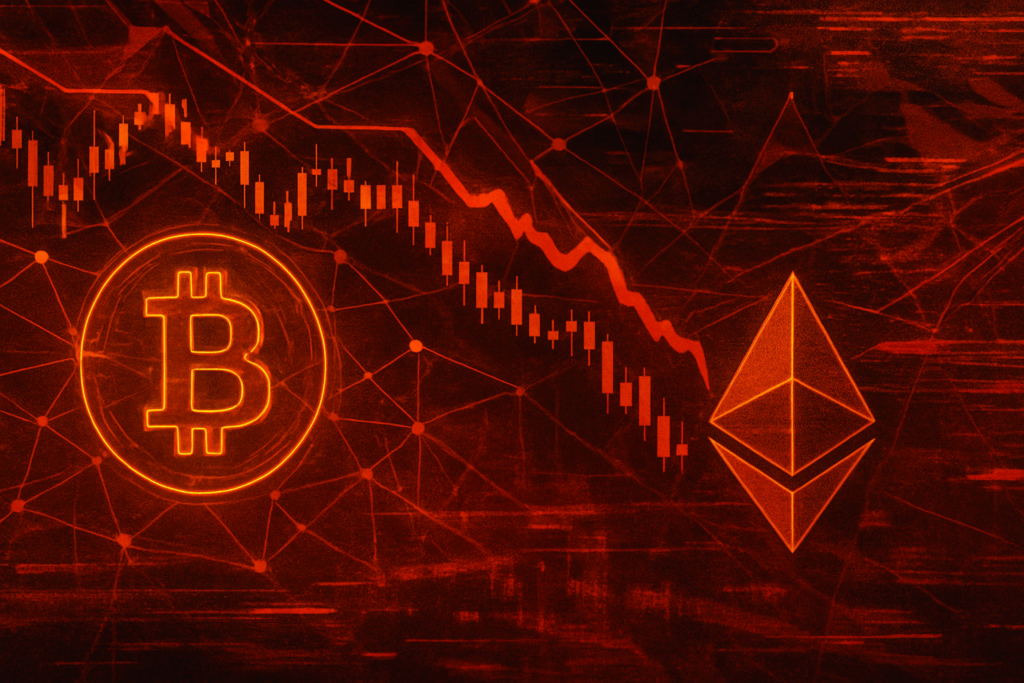Crypto Markets Reel from $19 Billion Crash Amidst Intensifying US-China Trade War Fears

October 12, 2025 – The cryptocurrency market has been plunged into chaos, experiencing a staggering $19 billion liquidation event between October 10 and 12, 2025, directly following an incendiary announcement regarding US-China trade relations. This seismic shift, dubbed by data tracker Coinglass as "the largest liquidation event in crypto history," saw digital assets across the board plummet, leaving investors reeling and major exchanges facing accusations of exacerbating the crisis.
The catalyst for this unprecedented downturn was a declaration from former U.S. President Donald Trump on October 10, 2025, outlining plans to impose a sweeping 100% tariff on all Chinese imports and introduce stringent export controls on "any and all critical software." This aggressive stance, framed as a countermeasure to China's "aggressive trade position" and recent export restrictions on vital rare earth minerals, sent shockwaves not only through traditional financial markets but critically, through the highly leveraged crypto ecosystem. The immediate and brutal market reaction underscores the growing sensitivity of digital assets to geopolitical tensions, highlighting how macro-economic and political shifts can trigger cascading effects in the interconnected global financial landscape.
Market Impact and Price Action
The fallout from Trump's announcement was swift and devastating for crypto markets. Within the first hour, over $7 billion in leveraged positions were liquidated, a figure that surged past $19 billion within 24 hours, impacting an estimated 1.6 million traders. Bitcoin (BTC), the market's bellwether, suffered a precipitous drop from a high of over $125,000 to briefly touch below $102,000 before finding some stability around $113,000. This represented a significant loss of over 18% from its peak in a single day, shattering key psychological support levels.
Ethereum (ETH) mirrored Bitcoin's distress, plunging by approximately 12%, while a multitude of major altcoins experienced even more severe double-digit declines. Solana (SOL), XRP, BNB, Litecoin (LTC), Toncoin (TON), and Dogecoin (DOGE) were among the hardest hit, with some tokens witnessing falls as steep as 51%. The total cryptocurrency market capitalization evaporated from $4.30 trillion to $3.74 trillion in a single trading day, wiping out hundreds of billions in value. The panic wasn't confined to crypto; the traditional S&P 500 Index also registered a slide of over 2%, indicating a broader market flight to safety amidst the escalating trade war rhetoric.
Technical analysis reveals a clear breakdown of critical support levels across most major cryptocurrencies. Bitcoin's brief dip below $102,000 indicated a failure to hold the psychological $100,000 mark, though a quick bounce suggests strong buying interest at lower levels. However, the sheer volume of liquidations points to an overleveraged market vulnerable to external shocks, reminiscent of flash crashes seen in early 2020 or during periods of intense regulatory FUD. The current market structure, characterized by high volatility and a fear index spiking, suggests that while some short-term relief rallies might occur, significant resistance levels will need to be overcome for a sustained recovery.
Community and Ecosystem Response
The crypto community's reaction was a mix of outrage, concern, and cautious optimism. Widespread anger erupted over severe technical issues reported on major exchanges during the peak of the crash. Binance, the world's largest crypto exchange, faced a barrage of complaints regarding frozen accounts, failed stop-loss orders, and inexplicable flash crashes that briefly sent some altcoins to near zero. While Binance attributed these disruptions to "heavy market activity," many in the community alleged that the outages amplified the crash's impact and, controversially, allowed the exchange to profit from the massive wave of forced liquidations. Similar operational glitches were also reported on other prominent platforms like Coinbase (NASDAQ: COIN) and Robinhood (NASDAQ: HOOD), further fueling community frustration and calls for greater transparency and reliability from centralized entities.
Social media platforms, particularly Crypto Twitter and Reddit, became hotbeds of frantic discussions. Sentiment largely shifted from bullish exuberance to extreme fear, with the Crypto Fear & Greed Index plummeting to "Extreme Fear" levels. Crypto influencers and thought leaders offered varied perspectives; some warned of potential broader market contagion and counterparty risks, speculating that total liquidations could ultimately exceed $30 billion once smaller exchanges and DeFi platforms were fully accounted for. Others, like Edul Patel, CEO of Mudrex, adopted a more sanguine view, suggesting that historical October corrections often precede relief rallies and that the current dip could represent a strategic buying opportunity for long-term investors in fundamentally strong assets like Bitcoin and Ethereum.
The impact extended beyond spot markets, affecting related DeFi protocols, NFT projects, and Web3 applications. Many DeFi protocols saw significant liquidations in their lending pools as collateral values dropped, increasing systemic risk within the decentralized finance ecosystem. NFT floor prices experienced a noticeable dip as investors de-risked across the board, and several Web3 projects saw their native tokens tumble, potentially slowing development and adoption in the short term. An unusual event preceding the crash – a crypto trader reportedly opening a massive Bitcoin short position 30 minutes before Trump's announcement and closing it for an estimated $88 million profit – also ignited fervent speculation of insider knowledge, prompting widespread calls for an immediate investigation into market manipulation.
What's Next for Crypto
The immediate short-term outlook for the crypto market remains highly volatile and uncertain, largely contingent on the evolving geopolitical landscape and the actual implementation of the proposed US tariffs. Should the tariffs on Chinese imports and software export controls proceed as planned on November 1, 2025, the market could face renewed pressure, potentially triggering further sell-offs as investors brace for a prolonged period of global economic instability. Conversely, any softening of Trump's stance or a diplomatic resolution could provide a much-needed catalyst for a market rebound.
In the long term, this event serves as a stark reminder of crypto's increasing interconnectedness with global macroeconomic and political forces. Projects and investors must strategically consider the implications of such external shocks. For projects, this means prioritizing robust risk management, diversifying treasury holdings, and focusing on building resilient, utility-driven ecosystems that can weather market downturns. For investors, the emphasis shifts to fundamental analysis, responsible leverage, and a long-term investment horizon, rather than speculative trading.
Potential catalysts to watch include any official statements from the Biden administration or the Chinese government regarding the proposed tariffs, economic data releases indicating the health of global trade, and the ongoing investigations into alleged market manipulation during the crash. Possible scenarios range from a swift recovery if geopolitical tensions de-escalate, to a prolonged bear market if the trade war intensifies and global economic growth falters. The likelihood of a sustained recovery hinges on the ability of Bitcoin to reclaim and hold key resistance levels, particularly the $120,000 mark, and the broader market's capacity to absorb further shocks without cascading liquidations.
Bottom Line
The recent $19 billion crypto market crash, inextricably linked to the escalating US-China trade tensions, is a pivotal moment for the digital asset space. For crypto investors and enthusiasts, the key takeaway is the undeniable impact of macro-geopolitical events on what was once perceived as a largely uncorrelated asset class. This event underscores the critical need for a diversified portfolio, responsible risk management, and a deep understanding of the broader economic and political forces at play.
The long-term significance of this crash lies in its potential to reshape market behavior and regulatory scrutiny. The technical failures on major exchanges and the allegations of insider trading will undoubtedly intensify calls for greater regulation, transparency, and consumer protection within the crypto industry. While the immediate pain is palpable, some analysts view this as a necessary deleveraging event, potentially paving the way for a healthier, more sustainable market in the future, where value is derived from fundamental utility rather than excessive speculation.
Ultimately, what this means for crypto adoption is a mixed bag. On one hand, such dramatic volatility can deter new entrants and reinforce skepticism about the asset class. On the other, the resilience shown by Bitcoin and Ethereum in recovering from their absolute lows, coupled with the continued innovation in DeFi and Web3, suggests that the underlying technology and its potential remain compelling. Important dates, events, or metrics to monitor include the November 1, 2025, deadline for the proposed tariffs, any subsequent trade negotiations, and the ongoing efforts by exchanges to address their technical shortcomings and restore user trust. The market's ability to absorb these shocks and demonstrate maturity will be crucial for its continued evolution and mainstream acceptance.
This article is for informational purposes only and does not constitute financial or investment advice. Cryptocurrency investments carry significant risk.
More News
View More




Recent Quotes
View More
Quotes delayed at least 20 minutes.
By accessing this page, you agree to the Privacy Policy and Terms Of Service.